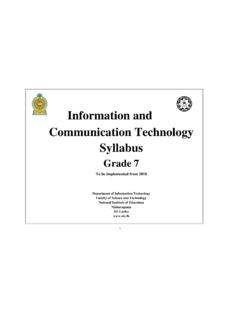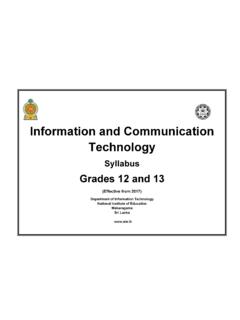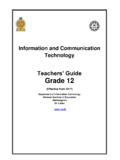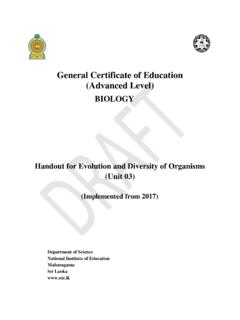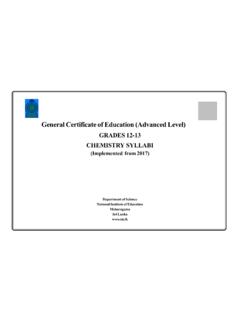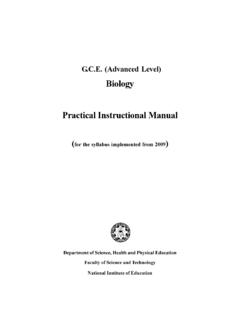Transcription of G.C.E Advanced Level - nie.lk
1 Advanced Level ACCOUNTING Teachers Guide Grade 12 (To be implemented from 2017) Draft Department of Business Studies Faculty of Science and technology National Institute of Education Maharagama. _____ Learning Outcomes and Model Activities Competency : Analyses accounting and its need Competency Level : Evaluates the importance of providing accounting information to the parties who are interested in making decisions. No. of periods : 02 Learning outcomes : Explain what is Accounting Explain the objective of Accounting. Names the stakeholders of a business. Analyses the information requirements of the stakeholders of an organization on a grid. Explains the classifications of Accounting. Basic Terms and Concepts Concept Map Accounting and its needs Objective Stakeholders Introduction Types of Accounting Management Accounting Financial Accounting Process Process Differences Reasons for their interest Learning Teaching process Engagement Introduce the business of to the students in a suitable manner.
2 Milinda commenced a service organization in media and communication having made an initial investment of ,000. All transactions relating to this business have been recorded as given below. 1. Loan transactions recorded in a Loan register 2. Cash transactions recorded in a rough Cash Book 3. Personal information about customers is recorded in a separate book. Two years later, based on the responsiveness of customers to its services Milinda decided to expand his business. For this purpose a further capital input of ,000 was the estimated requirement which was proposed to be met with a Bank loan. The bank has informed that they require financial statements of the past two years in order to provide this sum as a loan. Based on the information in this situation lead a discussion with the students that will cover the following areas: 1.
3 That the transactions in an organization include financial and non financialevents. 2. That there are several stakeholders in an organization while considering the reasons for their interest. 3. That the types of accounting can be differentiated as Financial Accounting and Management Accounting. 4. That there are distinct procedures in Financial and Management Accounting methods. 5. That there are differences in Financial and Management Accounting. 6. Thatthe objective of accounting is to provide information to relevant persons to enable them to make decisions. 7. That this provides a simple explanation of what accounting entails. Proposed instructions to assist learning: Divide the students to two groups. Prepare a questionnaire that includes the following: 1. State briefly what is meant by accounting.
4 2. What is the objective of accounting?. 3. State 4 stakeholders of a business enterprise. 4. State 1 reason each for the interest of each of the following stakeholders. a) Owner / owners b) Bank 5. Name the different types of accounting 6. What is Financial Accounting? 7. State the process in Financial Accounting 8. What is Management Accounting?. 9. Identify the process in Management Accounting. 10. Name 4 financial events. two events that are non- financial 12. Suggest two differences between Financial Accounting and Management Accounting. Allow the groups to select questions at random. (Instruct the students to state the question no. when requesting a question). Request the same group (in public) to suggest an answer to the question. If the correct answer is given credit them with 1 point and if the answer is incorrect, give the question to the next group.
5 Give points to the two groups in this manner whenever a correct answer is provided. If the students are unable to provide the correct answer, the teacher should give them the correct answer. Guidance on subject matter Different organizations have identified the definition of accounting as follows: American Accountancy Association (AAA) Accounting is the processof identifying, measuring and communicating economic information to permit informed judgements and decisions by the users of the information . American Institute of Certified Public Accountants (AICPA) Accounting is the art of recording, classifying and summarizing in a significant manner and in terms of money, transactions and events which are in part at least, of a financial character, and interpreting the results thereof.
6 If we consider the first definition of accounting we see that it is a general definition, while the second definition focuses attention on the process of financial accounting. Once we have studied these two definitions it is possible to arrive at a general definition as follows: Accounting is the process of providing relevant economic information to the concerned stakeholders to enable them to make appropriate decisions. This definition covers the economic information, accounting unit, accounting process, the stakeholders and their decision making. Objectives of accounting: The main objective of accounting is the communicating of economic information about the entity that will enable interested stakeholders to take decisions based on such information. The accounting entity can be an individual, an organization, the government, a business or any other unit.
7 Here, what we consider as economic factors is the basic financial information. Examples: The profit of the business during the financial year is ,000. The total assets of the business is ,000,000. The gross profit of the business is ,000. There is also information that is not of a financial nature but still important for the decision making of stakeholders. The workforce of the organization is 500. The business has a good reputation for its marketing of goods of high quality and in good condition. The business organization has good procedures for employee motivation. The stakeholders of the organization and the information needs for their interest are indicated in the following table. Interested Stakeholders The information requirements of the stakeholders 1.
8 Owner / Owners Has a satisfactory profit been made in accordance with the investment?. Should further investments be made?. 2. Management Are plans being implemented appropriately? What are the necessary plans/decisions for future 3. Employees Is there stability of employment? Is the business able to increase wages/salaries? 4. Government institution Eg: Tax department Are taxes being received on the due dates? Are relevant reports submitted to appropriate 5. Customers Are goods of good quality provided at reasonable prices? Does the organisation have a reputation and ability to honouring their commitments? 6. Creditors and lending Institutions Can the monies lent be recovered?. Is it feasible to extend further credit/loans?
9 Types of Accounting According to the different users of accounting information, accounting has two important divisions. Accounting Financial Accounting Management Accounting Financial Accounting Process Preparation of information about the past transactions of an entity in a manner that will enable external persons to make economic decisions is Financial Accounting. The provision of relevant information that will assist and support all levels of management to plan, control, make decisions in order to fulfil their responsibilities is Management Accounting. Recognition and Measurement Recording Classifying Summarizing Interpreting Transactions and events Financial Statements Input Process Output Management Accounting Process P Differences between Financial Accounting and Management Accounting Financial Accounting Management Accounting 1.
10 Uses historical information only 1. Uses historical and budgeted information 2. Provides information for internal and external users 2. Information is provided only for internal Users 3. Information is provided for a specific period of time 3. Provides information as and when Required by management. 4. Follows accounting concepts, rules and Regulations 4. Accounting concepts, rules and regulations and standards are not relevant Assessment and Evaluation Criteria Explaining accounting clearly Stating the objectives of Accounting Naming the stakeholders of the business and noting their information requirements Identifying given transactions and events as financial and non-financial . Stating the differences between financial accounting and management accounting.
